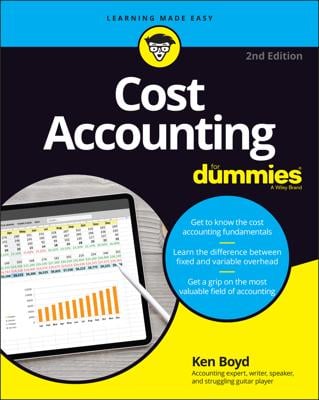Business cost distinctions help you better appreciate the cost figures for the things that your business produces or sells. Correct product costs (for businesses that sell products, of course) are extremely important.
Direct versus indirect costs: Direct costs are easy to match with a process or product, whereas indirect costs are more distant and have to be allocated to a process or product.
Fixed versus variable costs: If your business sells more units of a certain item, some of your costs increase accordingly (variable costs), but others don’t budge one bit (fixed costs).
Relevant versus irrelevant costs: Not every cost is important to every decision you need to make about your business. Hence the distinction between relevant and irrelevant costs:
Relevant costs: Costs that should be considered and included in your analysis when deciding on a future course of action. Relevant costs are future costs — costs that you would incur, or bring upon yourself, depending on which course of action you take.
For example, say that you want to increase the number of books that your publishing business produces next year in order to increase your sales revenue, but the cost of paper has just shot up. That cost will affect your bottom-line profit and may negate any increase in sales volume that you experience (unless you increase the sales price). The cost of paper is a relevant cost.
Irrelevant costs: Costs that you should disregard when deciding on a future course of action; if brought into the analysis, these costs could cause you to make the wrong decision. An irrelevant cost is a vestige of the past — that money is gone.
For example, suppose that your supervisor tells you to expect a slew of new hires next week. All your staff members use computers now, but you have a bunch of typewriters gathering dust in the supply room. Should you consider the cost paid for those typewriters in your decision to buy computers for all the new hires? Absolutely not — that cost should have been written off and is no match for the cost you’d pay in productivity (and morale) for new employees who are forced to use typewriters.
Actual, budgeted, and standard costs: The actual costs your business incurs may differ (though hopefully not significantly) from its budgeted and standard costs:
Actual costs: Historical costs, based on actual transactions and operations for the period just ended, or going back to earlier periods.
Budgeted costs: Future costs, for transactions and operations expected to take place over the coming period, based on forecasts and established goals.
Standard costs: Costs, primarily in the area of manufacturing, that are carefully engineered based on detailed analysis of operations and forecast costs for each component or step in an operation.
Product versus period costs: Some costs are linked to particular products, and other costs (not linked to products) are recorded as expenses immediately, without passing through the inventory account.

